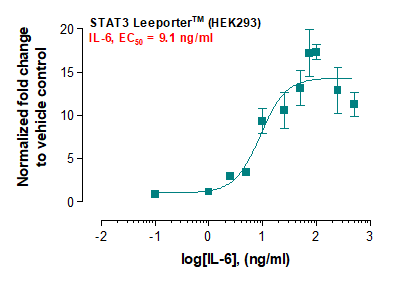Recombinant Human S100 Calcium Binding Protein P
Shipping Info:
For estimated delivery dates, please contact us at [email protected]
| Amount : | 10 µg |
| Purification : | Greater than 95% as determined by SDS-PAGE. |
| Content : | Filtered (0.4µm) and lyophilized from 0.5 mg/ml in 0.05M Phosphate buffer pH7.2, 0.1M NaCl. |
| Storage condition : | Store lyophilized protein at -20°C. Aliquot the product after reconstitution to avoid repeated freezing/thawing cycles. Reconstituted protein can be stored at 4°C for a limited period of time; it does not show any change after two weeks at 4°C. |
| AA sequence : | MTELEAAMGM IIDVFSRYSG SEGSTQTLTK GELKVLMEKE LPGFLQSGKD KDAVDKLLKD LDANGDAQVD FSEFIVFVAA ITSACHKYFE KAGLK. |
| Alternative Name : | Protein S100-P, S100 calcium-binding protein P, S100P, S100E, MIG9. |
Source : Escherichia Coli.
The Recombinant Human S100P has a molecular mass of 10.4 kDa containing 95 amino acid residues of the human S100P.
S100P was originally described as a placental protein of 95 amino acid residues shares about 50% sequence identity with the brain S100 proteins alpha and beta.S100 proteins are small dimeric members of the EF-hand superfamily of Ca(2+) binding proteins thought to participate in mediating intracellular Ca(2+) signals by binding to and thereby regulating target proteins in a Ca(2+)-dependent manner. S100P in addition to binding Ca2+, also binds Zn2+ and Mg2+. S100P gene is located on chromosome 4p16.S100P is dysregulated in the androgen-independent prostate cancer cell lines LNCaP-R, DU145, and PC3 and may play a role in the etiology of prostate cancer.In ductal hyperplasias, in situ and invasive ductal carcinoma, but not in the normal tissues, S100P overexpression is an early event that might play an important role in the immortalization of human breast epithelial cells in vitro and tumor progression in vivo.In NIH3T3 cells, the expression of S100P led to the presence of S100P in the culture medium, increased cellular proliferation, and enhanced survival following detachment from the culture substrate or after exposure to the chemotherapeutic agent 5-flurouracil. The proliferation and survival effects of S100P expression were duplicated in a time- and concentration-dependent manner by extracellular addition of purified S100P to wild-type NIH3T3 cells and correlated with the activation of Erks and NFB.To determine the mechanisms involved in these effects, we tested the hypothesis that S100P activated RAGE (Receptor for Activated Glycation End-Products). It was found that S100P coimmunoprecipitated with RAGE. Furthermore, the effects of S100P on cell signaling, proliferation and survival were blocked by agents that interfere with RAGE including administration of an amphoterin derived peptide known to antagonize RAGE activation, anti-RAGE antibodies and by expression of a dominant negative RAGE. These data suggest that S100P can act in an autocrine manner via RAGE to stimulate cell proliferation and survival.
Add 0.2 ml of deionized H2O and let the lyophilized pellet dissolve completely.
For Research Use Only. Not for use in diagnostic/therapeutics procedures.
|
There are currently no product reviews
|














.png)














